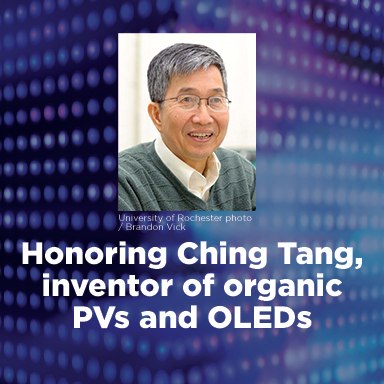Ching Tang
Ching Tang is one of the founders of organic semiconductor device technology. His landmark work while at the Eastman Kodak Company in the 1980s resulted in the invention of multilayer, small-molecule organic photovoltaics (OPVs) and organic light-emitting diodes (OLEDs). Through these breakthroughs, he and his colleagues demonstrated that organic semiconductors could function in ways analogous to inorganic semiconductors in their ability to transport charge and absorb or emit light. Read more about Ching Tang on SPIE News, or read about other SPIE Luminaries.

Photoswitchable gas permeation membranes based on azobenzene-doped liquid crystals
(Proceedings of SPIE, 2009)
Glassy nematic conjugated oligomers: materials for organic light-emitting diodes
(Proceedings of SPIE, 2004)
Evidence of electron and hole transfer in metal/CuPc interfaces
(Proceedings of SPIE, 2003)
Energy level alignment in metal/organic interfaces: Ca/Alq3 and Al/Alq3
(Proceedings of SPIE, 2001)
Degradation mechanisms in organic light-emitting diodes
(Proceedings of SPIE, 2000)
Energy alignment and trap states in dye-doped tris-8-(hydroxyquinoline) aluminum light-emitting devices
(Proceedings of SPIE, 1999)
Interface formation between Al and Ca with tris-(8-hydroxyquinoline) aluminum
(Proceedings of SPIE, 1999)
Trap states in doped tris-8-(hydroxyquinoline) aluminum using thermally stimulated luminescence
(Proceedings of SPIE, 1998)
Fluorescent dopants in organic electroluminescent devices
(Proceedings of SPIE, 1998)
Interfaces in organic light-emitting devices: quenching of luminescence
(Proceedings of SPIE, 1997)
Polysilicon TFT active matrix organic EL displays
(Proceedings of SPIE, 1997)


